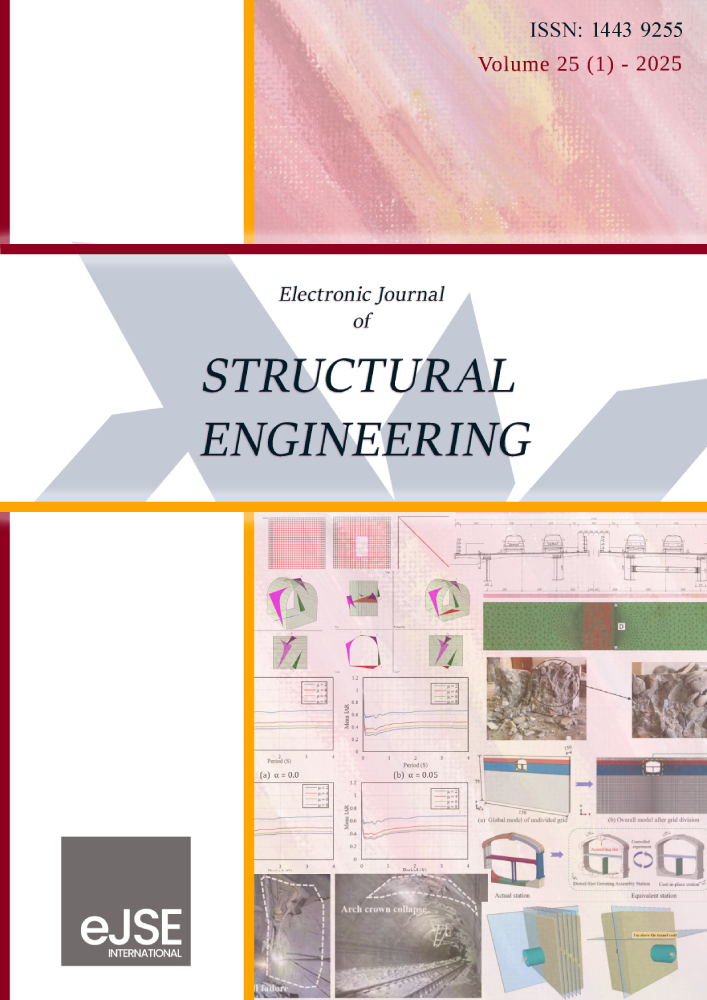Impact of Incorporating Plastic Fibers, Walnut Shells, and Tire Rubber Fibers on the Mechanical Properties of Concrete
DOI:
https://doi.org/10.56748/ejse.24738Keywords:
Concrete, waste materials, mechanical properties, sustainability, recyclingAbstract
There are serious environmental issues as a result of the increasing amount of waste generated worldwide, especially from industrial and commercial growth. In order to improve the mechanical characteristics of concrete and address waste management, this study explores the possibility of adding three distinct waste materials—plastic fibers, walnut shells, and tire rubber fibers—as additives. In addition to a reference mixture devoid of waste materials, four concrete mixtures were made, each including 1.0% of the cement weight of waste materials. To assess the mechanical properties, such as compressive, splitting tensile, and flexural strengths, extensive testing was carried out on cubic, cylindrical, and prismatic specimens. The findings showed clear differences in performance between the various waste materials. Notably, in comparison with the reference mix, the compressive strength of tire rubber fibers and walnut shells increased by 4.9% and 8.7%, respectively. Likewise, improvements in flexural strength were observed, with tire rubber fibers improving strength by 8.9% and walnut shells by 11.1%. On the other hand, in every evaluated property, plastic fibers continuously showed decreased mechanical performance. Workability studies revealed that all waste-modified mixtures had decreased slump values; nevertheless, because of its porosity and rough surface, the walnut shell mix had the lowest workability. Across waste-modified mixes, splitting tensile strength dropped consistently, with decreases ranging from 11.5% to 12.4%. By showing the potential of waste materials in concrete production, this study sheds light on the mechanical behavior of concrete that incorporates various waste materials, thereby promoting sustainable construction practices.
Downloads
References
Ahmad, J., Z. Zhou, A. Majdi, M. Alqurashi and A. F. Deifalla (2022). "Overview of Concrete Performance Made with Waste Rubber Tires: A Step toward Sustainable Concrete." Materials 15(16): 5518.
Al-Luhybi, A. S. and D. N. Qader (2021). "Mechanical Properties of Concrete with Recycled Plastic Waste." Civil and Environmental Engineering 17(2): 629-643.
ASTM-C143/C143M-12 (2012). Standard Test Method for Slump of Hydraulic-Cement Concrete.
ASTM(C469-02) (2010). Standard Test Method for Static Modulus of Elasticity and Poisson's Ratio of Concrete in Compression.
Awad, S., Y. Zhou, E. Katsou, Y. Li and M. Fan (2021). "A critical review on date palm tree (Phoenix dactylifera L.) fibres and their uses in bio-composites." Waste and biomass valorization 12: 2853-2887.
Awoyera, P. O. and A. Adesina (2020). "Plastic wastes to construction products: Status, limitations and future perspective." Case Studies in Construction Materials 12: e00330.
Babafemi, A. J., B. Šavija, S. C. Paul and V. Anggraini (2018). "Engineering properties of concrete with waste recycled plastic: A review." Sustainability 10(11): 3875.
Bajracharya, R. M., A. C. Manalo, W. Karunasena and K.-t. Lau (2017). "Durability characteristics and property prediction of glass fibre reinforced mixed plastics composites." Composites Part B: Engineering 116: 16-29.
BS(EN-12390-3) (2019). Testing hardened concrete - Compressive strength of test specimens.
Cajka, R., Z. Marcalikova, M. Kozielova, P. Mateckova and O. Sucharda (2020). "Experiments on fiber concrete foundation slabs in interaction with the subsoil." Sustainability 12(9): 3939.
da Costa, J. P., P. S. Santos, A. C. Duarte and T. Rocha-Santos (2016). "(Nano) plastics in the environment–sources, fates and effects." Science of the total environment 566: 15-26.
Ferriz-Papi, J. A. and S. Thomas (2020). "Recycled aggregates from construction and demolition waste in the production of concrete blocks." Journal of Construction Materials 2(1).
IQS(No.5) (2009). Characteristics of Ordinary Portland Cement.
Jnr, A. K.-L., D. Yunana, P. Kamsouloum, M. Webster, D. C. Wilson and C. Cheeseman (2018). "Recycling waste plastics in developing countries: Use of low-density polyethylene water sachets to form plastic bonded sand blocks." Waste Management 80: 112-118.
Lehne, J. and F. Preston (2018). "Making concrete change." Innovation in Low-carbon Cement and Concrete.
Mohammed, V. R., K. N. Abdulhaleem, H. M. Hamada, A. M. Humada and A. Majdi (2023). Effect of Recycled Aggregate Concrete and Steel Fibers on the Fresh Properties of Self-Compacting Concrete. E3S Web of Conferences, EDP Sciences.
Omary, S., E. Ghorbel and G. Wardeh (2016). "Relationships between recycled concrete aggregates characteristics and recycled aggregates concretes properties." Construction and Building Materials 108: 163-174.
Pacheco-Torgal, F. (2019). Introduction to the use of recycled plastics in eco-efficient concrete. Use of recycled plastics in eco-efficient concrete, Elsevier: 1-8.
Ragaert, K., L. Delva and K. Van Geem (2017). "Mechanical and chemical recycling of solid plastic waste." Waste management 69: 24-58.
Santhanam, N., B. Ramesh and F. K. Pohsnem (2020). "Concrete blend with E-waste plastic for sustainable future." Materials Today: Proceedings 22: 959-965.
Shawais, Z. A., K. N. Abdulhaleem, S. H. Ahmed, H. M. Hamada and V. R. Mohammed (2024). Influence of Recycled Coarse Aggregate and Steel Fiber on the Workability and Strength of Self-Compacting Concrete. IOP Conference Series: Earth and Environmental Science, IOP Publishing.
Snell, C., B. Tempest and T. Gentry (2017). "Comparison of the thermal characteristics of Portland cement and geopolymer cement concrete mixes." Journal of Architectural Engineering 23(2): 04017002.
Tavakoli, D., M. Hashempour and A. Heidari (2018). "Use of waste materials in concrete: A review." Pertanika J. Sci. Technol 26(2): 499-522.
Zeyad, A. M. (2020). "Effect of fibers types on fresh properties and flexural toughness of self-compacting concrete." Journal of Materials Research and Technology 9(3): 4147-4158.
Zhang, B. and C. S. Poon (2018). "Sound insulation properties of rubberized lightweight aggregate concrete." Journal of cleaner production 172: 3176-3185.
Downloads
Published
How to Cite
Issue
Section
License
Copyright (c) 2025 Diyar N. Qader, Hammad D. Merie, Khamees N. Abdulhaleem

This work is licensed under a Creative Commons Attribution 4.0 International License.







